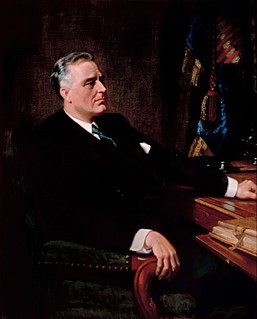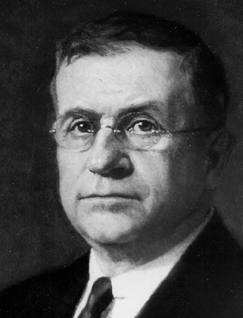This page is based on this
Wikipedia article Text is available under the
CC BY-SA 4.0 license; additional terms may apply.
Images, videos and audio are available under their respective licenses.

The Indian Reorganization Act of June 18, 1934, or the Wheeler-Howard Act, was U.S. federal legislation that dealt with the status of Native Americans. It was the centerpiece of what has been often called the "Indian New Deal". The major goal was to reverse the traditional goal of assimilation of Indians into American society and to strengthen, encourage and perpetuate the tribes and their historic traditions and culture.

Public Works Administration (PWA), part of the New Deal of 1933, was a large-scale public works construction agency in the United States headed by Secretary of the Interior Harold L. Ickes. It was created by the National Industrial Recovery Act in June 1933 in response to the Great Depression. It built large-scale public works such as dams, bridges, hospitals, and schools. Its goals were to spend $3.3 billion in the first year, and $6 billion in all, to provide employment, stabilize purchasing power, and help revive the economy. Most of the spending came in two waves in 1933-35, and again in 1938. Originally called the Federal Emergency Administration of Public Works, it was renamed the Public Works Administration in 1935 and shut down in 1944.
The United States maintained its Representative Democracy government structure throughout World War II. Certain expediencies were taken within the existing structure of the Federal government, such as conscription and other violations of civil liberties, and the internment and later dispersal of Japanese-Americans. Still, elections were held as scheduled in 1944.
Ickes is a surname and may refer to:
Edwin Wendell Pauley Sr. was an American businessman and political leader.
Charles A. Harwood was an American lawyer and politician from New York, and Governor of the United States Virgin Islands.
The Slattery Report, officially titled The Problem of Alaskan Development, was produced by the United States Department of the Interior under President Franklin D. Roosevelt's secretary Harold L. Ickes in 1939–40. It was named after Undersecretary of the Interior Harry A. Slattery. The report, which dealt with Alaskan development through immigration, included a proposal to move European refugees, especially Jews from Nazi Germany and Austria, to four locations in Alaska, including Baranof Island and the Matanuska-Susitna Valley. Skagway, Petersburg and Seward were the only towns to endorse the proposal.

Harry A. Slattery, was an American lawyer and statesman. He was United States Under Secretary of the Interior from 1938–39 and gave his name to the Slattery Report, which proposed to develop Alaska through immigration. The proposal, which included the settlement of Jewish refugees from Germany and Austria, largely in response to Nazi antisemitism, was never implemented.

Milton Holmes Welling was a U.S. Representative from Utah.
Escalante National Monument was proposed by Secretary of the Interior Harold Ickes in the 1930s as a unit of the U.S. National Park Service in the canyonlands of south central Utah. Centering on the canyons of the Escalante River, the proposed monument encompassed portions of present-day Canyonlands and Capitol Reef national parks, Natural Bridges and Grand Staircase-Escalante national monuments and Glen Canyon National Recreation Area. The proposed national monument was to encompass about 4,500,000 acres (1,800,000 ha). The Second World War interrupted Ickes initiative, which had encountered resistance from Utah politicians.
Michael Wolf Straus (1897–1970) was the Commissioner of the United States Bureau of Reclamation from 1945 until 1953.
The Ickes Mountains are a series of coastal mountains that extend west from Strauss Glacier for 15 miles (24 km) in Marie Byrd Land, Antarctica. The mountains were discovered from aircraft of the U.S. Antarctic Service on December 18, 1940. The name Ickes Mountains, after U.S. Secretary of the Interior Harold L. Ickes, appeared in the maps and reports resulting from this expedition although Ickes objected and never acquiesced to the use. Nonetheless, the name became established in usage and in 1966 was approved by the Advisory Committee on Antarctic Names. The U.S. Antarctic Service was established in the Division of Territories and Island Possessions of the Department of the Interior in 1939, during the period (1933–46) that Ickes was secretary.

The Interior Museum is a museum operated by the United States Department of the Interior and housed at the Department's headquarters at the Stewart Lee Udall Main Interior Building in Washington, D.C., on the first floor.

The U.S. General Services Administration Building is a historic office building located at Washington, D.C.. It was built originally to house offices of the United States Department of the Interior.

The Main Interior Building, officially known as the Stewart Lee Udall Department of the Interior Building, located in Washington, D.C., is the headquarters of the United States Department of the Interior.
Louis Russell Glavis (1883–1971) was an American lawyer and an employee of the United States Department of the Interior. He was a prominent figure in the 1910 Pinchot-Ballinger Controversy;
a political dispute between President Taft's Secretary of Interior, Richard Ballinger and conservationist Gifford Pinchot over Governmental conservation policies.

The presidency of Franklin D. Roosevelt began on March 4, 1933.









